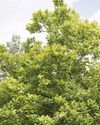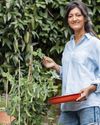
Most of us have a patch of dusty earth - even those of us who garden on what is diplomatically called 'stiff' soil. It may be open to drying winds and baking sunshine and, as a result, it will be capable of being transformed into a dustbowl with remarkable rapidity once the endless spring rains are nothing but a memory.
Alternatively, the patch of earth may be shaded but sucked dry of moisture by a dense network of tree roots. Either way, all is not lost. The secret (which is obvious when you come to think of it) is to grow plants that are naturally suited to dry soils and limited supplies of moisture. They do exist and they are not all natives of the Sahara Desert.
Since Beth Chatto wrote her definitive book The Dry Garden back in 1978, our climate has continued to be volatile. We have endured wetter springs and milder winters, which has necessitated a reappraisal of those plants that are deemed suitable for periodically dry soils. Not only must they be tolerant of a lack of moisture in summer, but they must also be able to withstand greater extremes of moisture content in terms of winter wet.
Overseas influences
Plants from arid countries can often cope with low temperatures in winter, as long as they are not subjected to waterlogging at the roots or excessively damp atmospheric conditions that are amenable to fungus diseases that can lead to rotting foliage. From this you will see that a free-draining soil, coupled with freely moving rather than stagnant air, will do much to ameliorate things and give drought-tolerant plants a better chance of survival.
Diese Geschichte stammt aus der July 2024-Ausgabe von BBC Gardeners World.
Starten Sie Ihre 7-tägige kostenlose Testversion von Magzter GOLD, um auf Tausende kuratierte Premium-Storys sowie über 8.000 Zeitschriften und Zeitungen zuzugreifen.
Bereits Abonnent ? Anmelden
Diese Geschichte stammt aus der July 2024-Ausgabe von BBC Gardeners World.
Starten Sie Ihre 7-tägige kostenlose Testversion von Magzter GOLD, um auf Tausende kuratierte Premium-Storys sowie über 8.000 Zeitschriften und Zeitungen zuzugreifen.
Bereits Abonnent? Anmelden

A new plot for tasty crops
Taking on a new allotment needn't be hard work. By simply following a few easy tips you can have bumper crops in no time, just like Alessandro Vitale

We love July
July is an island floating between the joy of June and the slightly fatigued month of August. It's a grown-up month: the year has shrugged off its adolescent exuberances, the weather is (hopefully) warm enough for ice cream to be one of your five a day, the sea should be swimmable without (too much) danger of hypothermia and thoughts will be of holiday shenanigans and family barbecues. School's out this month, the next tranche of glorious summer colour is washing across our borders and it's my birthday. Lots of reasons to give three rousing cheers for July!

YOUR PRUNING MONTH
Now, at the height of summer, Frances Tophill shows how to boost your plants' health and productivity with a timely cut

Hassle-free harvests
Flowers are out in abundance this month and for Jack Wallington, many of these blooms make delicious, low-effort pickings

Bite-sized bounties
Glorious doorstep harvests can easily turn into gluts, so let Rukmini Iyer's recipes help you savour every last bit

Upcycled outdoor living
Create unique and stylish garden features for minimal cost using reclaimed materials and simple DIY skills. Helen Riches shares four step-by-step projects and more inspiring eco tips

Secrets of a COLOURFUL GARDEN
Buildings and landscapes can play a vital role in supercharging your space, as Nick Bailey demonstrates

Greening up a city balcony
Looking for sustainable, small-space gardening ideas? Take inspiration from Oliver Hymans' transformed balcony garden in north-east London - now a lush, green haven for humans and wildlife

The dry and mighty garden
As we adapt our gardens to a more volatile climate, Alan Titchmarsh reveals how to create a drought-tolerant plot and picks his top plant performers

Nature knows best
Carol Klein explains how to choose plants for specific growing conditions, based on what has naturally adapted to thrive there